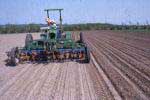 |
Soil preparation, microflora, fauna and nitrogen liberation
The advance of organic farming is being driven by the consumer (who wants pesticide-free foods and a richer wildlife environment) and the organic farmer (who would like to produce these products at an acceptable price). The objective of this project is to satisfy both of these interests. The project provides information that makes the organic farmer better able to influence the soil microflora and fauna to optimise the utilisation of nitrogen. It also provides knowledge about which natural qualities (i.e. the soil and soil surface microflora and fauna) come to pay the price for organic products. The project involves three areas of investigation: 1) soil preparation, 2) biological and physical aspects of the soil, and 3) modelling.
The study examines the significance of several soil tillage procedures (ploughing, harrowing and a combined tillage and sowing process inspired by the Dutzi-system) for the uptake of nitrogen, growth and crop yield. These procedures are combined with above-ground loosening of the soil between rows in the growing crop. Furthermore, the Kemink Exact system is being tested and developed. In these studies germination of the plant, its development and uptake of nitrogen throughout the growing season, the impact of weeds, the incidence of plant diseases, and the yield are all being monitored.
The biological and physical investigations concentrate on soil biology and its relationship to the pore structure produced by the various soil tillage procedures. The effect of the latter on soil nitrogen, soil fauna, and surface-dwelling predators in a selected field in the rotation used for the soil preparation studies, is also being addressed. Furthermore, a series of pioneering laboratory investigations into the dependence of soil organisms on pore structure and humidity, as well as their mutual trofic relationships, is also in hand. These results contribute to an understanding of field results and produce data for simulation models.
A simulation model is being produced by combining and expanding existing dynamic models for organic matter, microorganisms, soil fauna, and crop growth. These models are based on the physiological requirements of microorganisms and are dependent on measurements of temperature. The simulation model, which builds on information from the literature, from other organic farming projects, and from the present project, will be used to calculate how soil tillage activities influence the amount and quality of life in the soil, as well as the release of nitrogen. Together with experiences from the practical studies, this will be used to evaluate which procedures produce the greatest release of nitrogen during the growth period of the plant under different climatic conditions.
Summary
Publications
Project title
IV.3 Qualitative and quantitative relationships between soil preparation procedures, microflora, fauna and the timing of nitrogen release in organic farming
Project leader
Jørgen Aagaard Axelsen,
National Environmental Research Institute, Department of Terrestrial Ecology, Vejlsøvej 25, DK 8600 Silkeborg
Tel: +45 8920 1400, Fax: +45 8920 1413
E-mail: jaa@dmu.dk
Project participants
Susannah Elmholt, Kasia Debosz, Gunner Mikkelsen, Per Schjønning, Jørgen E. Olsen and Karl J. Rasmussen, Danish Institute of Agricultural Science
Paul Henning Krogh, Martin Holmstrup, Hanne Lakkenborg Kristensen and Helena Bracht Jørgensen, National Environmental Research Institute
Ole M. Christensen, Janice G. Mather, Trine Bilde and Boy Overgaard Nielsen, University of Aarhus
Peter Gjelstrup and Henning Petersen, Museum of Natural Sciences
Søren Christensen, University of Copenhagen
Jesper Rasmussen, The Royal Veterinary and Agricultural University
|